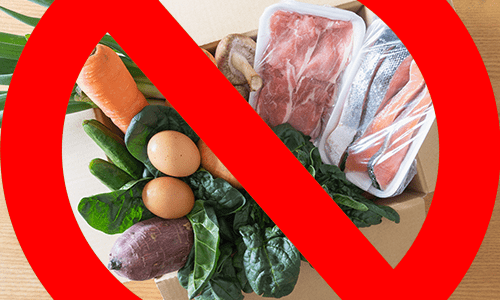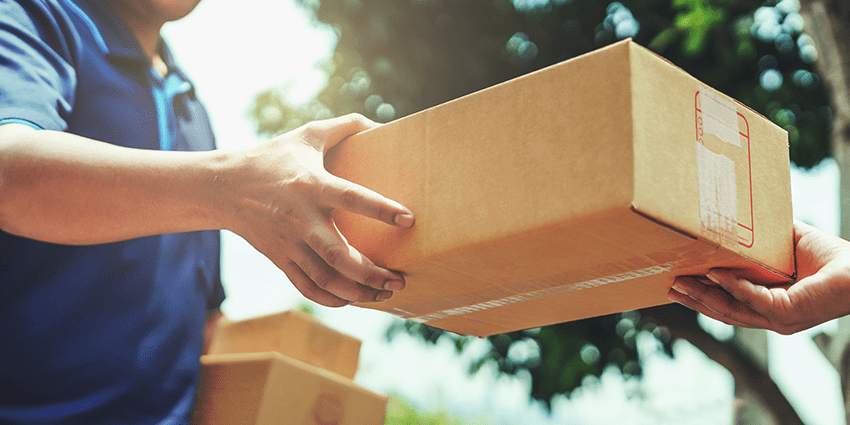Are you thinking of sending food in the post?
People send food by courier for many reasons. Some want to send food as a surprise gift or hamper, and others might because that food type isn’t available where their recipient lives. Either way, shipping food within the UK and abroad does have some restrictions, but we’re here to help guide you.
So, let’s take a bite out of confusing shipping rules and restrictions and explain how to deliver food safely.
What kind of food can you ship?
✔ Non-perishable food
You can send non-perishable food, providing it has a long shelf and is fully sealed in its original packaging. Examples of non-perishable food include dried pasta, biscuits, and sweets.
Before you send it, please check the following:
- The food has a shelf life of at least six months from the date of shipping
- The food packaging is sealed in the original manufacturer’s packaging
- The food labels list all ingredients
✔ Liquid (on specific Liquid services)
Liquid follows the same rules as non-perishable food. However, sending alcohol comes with additional restrictions. Our guide on sending alcohol explains the dos and don'ts of sending alcohol by courier.
It’s important to note that we offer dedicated liquid courier services like APC Liquid. Consignments on APC Liquid services are sorted by hand by specially trained staff to maximise protection during transit.
❌ Perishable food

The most important rule is that you cannot send perishable food items, i.e., food that can go off or spoil in transit. Even if you book a Next Day service, you cannot ship perishable goods as there’s always a risk of delays.
Examples of perishable food include fresh fruit, meat, dairy products and foods that require refrigeration.
You must check our Prohibited & Restricted Items list and the import restrictions in your shipping country. If you’re unsure, you can always speak to a member of Customer Services.
Can I send homemade food?
You cannot send homemade food by courier because it’s impossible to determine the ingredients, and it could spoil during delivery.
If you want to send a loved one some home comforts, why not make a hamper and include everything they need to make at home? You could include a hand-written recipe, utensils and some store-bought treats in your parcel.
Can I send food abroad?
You can send food abroad but there are more rules and regulations to consider. If you’re sending food to somebody overseas, you must check the rules with local customs and the courier.
For instance, America has the Food and Drug Administration (FDA) responsible for protecting public health, including the safety of food supply. Therefore, you must check with them if you require additional documentation for sending food to the United States.
When sending food abroad, you must also accurately complete a Customs Invoice to help speed your parcels through Customs clearance. Ensure you provide clear and accurate descriptions of your foodstuffs, including brand names and the value of each item. Don’t just put a general description like ‘personal items’ as it can result in delays or fines.
How do I send food?
When sending food by courier, you must ensure the food has not been tampered with and is in its original packaging, with the ingredients easily visible. Shipping cookies in a sandwich bag rather than the original box will cause more issues than it’s worth. Please don't tamper with the original packaging!
We recommend you select a sturdy, cardboard outer box and package your items well enough inside to withstand a slight tumble. This means you must fill gaps with packaging material to reduce internal movement and help ensure your food stays intact.
Which carriers accept food?
UK parcel delivery
Most UK couriers, like DHL, are happy to ship food through their parcel network.
However, DPD and Landmark Global do not accept food through their services. That’s why we ask you to check with the food courier before you book.
International parcel delivery
As we mentioned earlier, shipping food internationally is trickier. With some couriers, like Landmark Global, anything ‘consumable’ in general can be considered food. This includes vitamins, supplements and hydration sachets in certain countries. Therefore, we recommend you check with the country and the carrier.
Five key things to remember when shipping food:

1. Check with our Prohibited & Restricted Items list along with the destination country’s rules
2. Ensure you provide an accurate description of your goods when booking delivery and on the customs invoice (if sending internationally)
3. Keep the food in its original packaging so it displays the ingredients, expiration date, etc.
4. Package your items sufficiently for transit to reduce internal movement and wrap each item individually
5. If you're unsure then don't send it as you risk fines and/or delays
Once you’ve checked that your item is suitable to ship and packaged well, enter the parcel weight, dimensions and delivery destination online. You can get a quick quote for convenient parcel delivery services within seconds.
So, if you’re thinking, can I send food in the post? You know you’re in the right place.
Disclaimer: This blog post is for informational use only. You should always conduct your own research to verify the accuracy of this content. The information was accurate at the time of writing but may be subject to change.










 Facebook
Facebook Twitter
Twitter Instagram
Instagram Linked In
Linked In YouTube
YouTube